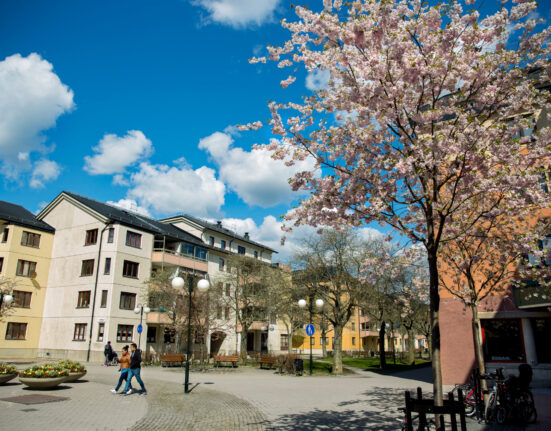Slow. Inefficient. Fair.
These are all words not to describe what it is like to buy a property in Sweden. More than any other, the cut-throat industry of real estate challenges perceptions of the Swedish stereotype.
It resembles nothing so much as riding the ‘Insane’ rollercoaster at Gröna Lund, from the highs of euphoria as you discover your dream home to the sickening lurch of how much it costs. You’re then treated to the tick-tick-tick of the steep ascent of the bidding process before a loop-the-loop of excitement when you’ve secured the deal. And after it’s all over, you wonder how you managed to be suckered into emptying your wallet to that extent.
You may also like:
- A guide to Stockholm’s Neighborhoods
- Living in Sweden | finding a rental apartment
- Finding a rental apartment in Stockholm
I exaggerate for effect. No roller coaster (in Sweden, anyway) is as fast as the process can take. As a French friend of mine remarked, ‘you buy an ‘ouse in this country the same way you buy an ‘air dryer”. Of course if you’re buying a bostadsrätt in Sweden as most people do, you’re not really buying the apartment: that’s owned by the housing association. What you buy is the right to live in the apartment. This doesn’t alter the pleasure of living in your dream place, but it does mean you can’t hire it out without permission.
Your first step should be to get your loan approval, ett lånelöfte, from the bank, which is built from your deposit and household income. The process has gotten harder since 1st October 2010, when the Finansinspektionen (FI for short; the government body monitoring the financial market) decreed that banks cannot loan more than 85% of the property price. This means that you will need to stump up a 15% deposit from your savings or other ill-gotten gains and it is your deposit that will probably determine your price bracket. But securing a loan for a property in Sweden warrants an article in itself; maybe I’ll write it one day. All you need to know for now is that it is critical to get a lånelöfte before you go a-flat hunting – it will save you heartache.
Once you have your loan agreement, the next step is to actually find your dream home. There are many ways to do this, including www.blocket.se (the ‘’air dryer’ image comes to mind again), your local paper and stepping into your local estate agent, but by far and away the most popular is by checking out www.hemnet.se. Here, the majority of homes in Sweden are put up on to a website by various estate agents, providing a one-stop shop for hopeful home-buyers. You will do well to put some limitations on your search before you discover that you can’t afford that 5-room, top-storey Penthouse apartment on Östermalm, even though it’s perfect.
the bidding process, a terrifying practice, in which you are given the option to text the estate agent with a bid of millions of kronor in the most casual manner, competing in money terms with other buyers texting in their bids
First things first, filter out price, which means the value of the property, but also the ‘avgift’, a communal charge payable to the housing association of the building, which might be servicing a loan from the bank to the housing association (typically for new-builds), cleaning, damages, renovations etc to any communal areas, along with heating, water and cable TV if you’re lucky – do check what yours will include. Be aware that the listed price of a home can have very little to do with how much the seller wants. In Stockholm’s property industry, the free market determines the final cost. There are 2 main categories of price that estate agents use: ‘Utgångspris’, a number used, frankly, to lure hemnet users in to looking at the apartment. This number is then subject to the bidding process, a terrifying practice, in which you are given the option to text the estate agent with a bid of millions of kronor in the most casual manner, competing in money terms with other buyers texting in their bids. Don’t go higher than your lånelöfte. The other main category, used more nowadays in the current slowing down of the property boom, is ‘acceptpris’, which is the price the seller intends to sell at, but is still subject to the bidding process. For both catgories, the seller can decide at any point that, actually, they’d rather not sell after all and you go back to the hemnet drawing board.
Do pay close attention to the transport links, because a 15 minute saunter to the T-bana in the summer becomes the grueling Olympian sport of pushing a pram uphill the same distance in the snow.
The apartment you finally end up with will typically be a balance between the price you can afford, the area and the space. We have an article on the different areas here. Do pay close attention to the transport links, because a 15 minute saunter to the T-bana in the summer becomes the grueling Olympian sport of pushing a pram uphill the same distance in the snow. For the same reason, look at the amenities in the area, the shops, the schools; dare I say it, the gym? Hey, we’re in dream property land here.
Space-wise, Swedes tend to look at size of the apartments in square metres, rather than how many rooms it has, but you can filter by both. Be aware that ‘3-rum’ does NOT mean 3 bedrooms. One ‘rum’ will be the living room – worth finding out before you realize you have nowhere to house the baby. I myself always look at the ‘planritning’, the layout of the flat – it’s the best way of seeing who can live where and whether you could live there at all.
Otherwise, you will have your own priorities when looking at an apartment but things to consider include:-
- Go through the condominium association’s recent annual report and try to assess the risk of future fee increases.
- Is it a genuine or spurious association?
- Find out if the housing association has decided on repairs that can affect the monthly fee in the future.
- Find out whether any major renovations (question closely about the pipes as these need to be replaced after a certain time) have been recently carried out in the property. Do you want to make any renovations? How much will they cost? Will they be approved by the board?
- When you can move into the apartment (Typically within 4 months)
- Whether you will have your own washing machine and dryer or share a laundry room, Tvättstuga
- Parking possibilities.
- Storage in the basement and / or attic (ask to see them).
- What is personal property and what will remain in the flat; often wardrobes are left whilst light fixtures are ripped out.
- Common areas: the laundry room, hall, stroller parking, bicycle storage and if you strike gold, a lokal or party room, which can include a bed, bathroom and kitchen and is hired out. (Find out what rules apply to those common areas).
So you’ve decided on what you want, in theory. Now to list all the visnings or showings of potential apartments in your area. I would recommend going to as many as you can stomach on a Sunday (the usual ‘visning’ day), even if you’re not interested. It’s the best way to work out what you do and don’t like. Visnings are half hour speed assessments, where other wishful homeowners talk loudly about all the things that are wrong with the apartment. Don’t be fooled, they just don’t want to have to bid against you. In fact, you might want to indulge in some dirty apartment talk yourself, so to speak.
Joking aside, there may be actual flaws with an apartment when you visit it. Determine which are cheap and easy to fix (wallpaper, lights) and which are expensive and time-consuming (flooring, plumbing). The main question to ask yourself when looking around is ‘can I live here? Is this my home?’ If it is, ask for another viewing (always worth doing), speak to the estate agents about any other issues you may have (they have a legal obligation to tell you) and hold onto your hat. The bidding war has commenced.
The estate agent has a list of interested parties that he will pester call with the latest highest price offer. You can increase your bid in as small increments as you like (if small is the right word to describe thousands of kronor) but always be aware of your limit and do not go beyond it. You can bid via the web on the estate agents page, via text or on the phone. Luck can play a huge element, as can time of year (there are a lot less bids in the summer, for example. Then again there are a lot less flats on offer; everyone’s on holiday). Keep cool and remember; you win some, you lose some. At some point no matter how much you want that flat, you might not be able to afford it or it simply is not good value for money. But I know of several people who have snaffled bargains; it does happen.
I’m going to assume that you’ve found your dream flat in your dream area at your dream price (lucky you). You will now get frantic calls from the estate agent to seal the deal as quickly as possible; everyone wants this process done with. Even if you’ve been lucky enough to get a private sale from someone, with no bidding process involved, it pays to have an estate agent at this point to make sure all the necessary paperwork is put together. You will be called into a room with the seller, whom you will generally never have seen before. You will be given all the terms and agreements, pay over your deposit and sign your name several times. After this meeting, any backing out means losing your deposit, although it is comforting to know that sellers have a liability for any errors in a sold property for up to 2 years after the purchaser moves in. The next and probably the last time you will see the seller is on exchange date itself when you move in, sign some more forms and transfer over an enormous amount of cash, represented by that huge debt that appears in your bank account.
This wordy article hasn’t really given the full flavour of the speed of the affair. Not to go all Craig David on you, but it can take even less than 7 days from browsing through hemnet for the first time to handing over a deposit. Most properties are put up on a Friday with visnings held over the weekend and Monday. The bidding starts on Tuesday and the final agreement should be done by the following Friday. Of course that’s the quickest type of sale. The perfect property can take days, weeks and months to find. But it’s usually the most expensive thing you’ll ever buy in your life; it’s worth getting right.
Post by Farrah Gillani
Original image by bomb_tea













12 Comments